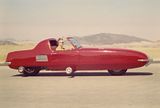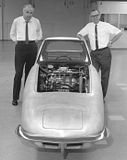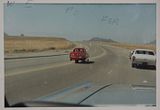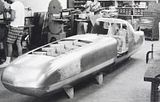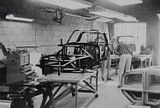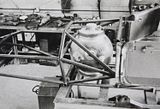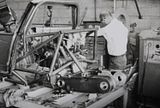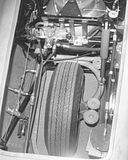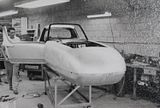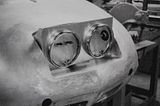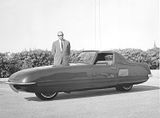Alex Tremulis was a man with a lively mind. The chief designer of Auburn, Cord and Duesenberg, the architect of the Tucker and the longtime head of Ford’s advanced design studios, Tremulis was fascinated by the future. In his later years, active as ever, he became captivated by the idea of gyro-stabilized vehicles: railcars, motorcycles and automobiles (the latter expressed in the Ford Gyron concept car). One of the products of that thinking, known as the Gyro-X, has only recently emerged from obscurity in the sympathetic hands of the Lane Motor Museum in Nashville, where founder Jeff Lane aims to have it restored and operational by the centenary of Tremulis’s birth in 2014. Powered by a 1,275cc four-cylinder from a Mini Cooper, most likely chosen because it was small and powerful, the Gyro-X was a single-seater with a tubular frame and an aluminum body. The rear wheel was driven by a chain. Keeping the vehicle upright, even when idling, was a hydraulically driven gyroscope that spun at 4,000 to 6,000 RPM; this was mounted in front of the driver. The single operational prototype was produced by Gyro Transport Systems Inc. of Northridge, California, founded in 1963 by Tremulis and gyroscope expert Thomas Summers, whose work had primarily been in rockets and missiles. Tremulis believed that the two-wheeled automobile was the cure for traffic congestion; at just 40 inches wide, it would allow the creation of twice as many lanes on existing highways, Jeff says. He was also promising fuel economy of up to 80 miles per gallon. “Alex Tremulis said, ‘Four wheels is two too many,’” Jeff said. “There were a lot of good ideas. Unfortunately, they weren’t able to communicate them.” The prototype was shown in 1967, attracting limited attention from Road & Track and Sports Cars Illustrated magazines, though Science and Mechanics magazine chose the car for the cover of its September 1967 issue. (There’s some footage of it under way on YouTube.) Why such a gee-whiz vehicle didn’t attract more notice, Jeff doesn’t know, although he theorizes that it might be because the prototype did not emerge until the company was on the brink of bankruptcy. Assailed by shareholders who wanted their $750,000 investment back, Gyro Transport Systems was out of business by 1970. In 1969, Summers would receive a patent on the car’s gyroscope and hydraulic control system. In the midst of the bankruptcy proceedings, the Gyro-X itself vanished. About five years ago, it re-emerged, offered for sale by John Needham, a Las Vegas musician who was also known by his stage name, John Windsor. Needham did not know the car’s identity; now minus its gyroscope, the Gyro-X had been converted to a trike, with a mid-mounted flat-four engine and gearbox from a Porsche 914 driving the (now) two rear wheels. Needham had obtained the car around 1994 as collateral for a debt that went unpaid; in 2004, he put up a YouTube video, seeking anyone who knew anything about the car. The car wound up at the Lane Motor Museum “through luck and good friends,” Jeff said. Collector Mark Brinker of Houston, Texas, heard about the car and bought it. He called Jeff to tell him about his find; “I had never heard of it. No idea,” he said. Mark had intended to restore the car, but changed his mind, and offered it to the Lane Motor Museum, known around the world as the home of the unusual; it has more than 330 cars and motorcycles in its collection, with 150 on display at any given time. The Lane seems the ideal home for the Gyro-X, which will share display space with such aeronautically inspired vehicles as a propeller-driven car by Marcel Leyat and a Voisin C-28. “Tremulis was always on the go, always thinking of the future, always wanting to try innovative things,” Jeff said. “He’s like [Gabrielle] Voisin, he’s like Leyat – he was always thinking and dreaming.” No one has any idea what happened to the car’s gyroscope, Jeff said, though speculation is that Summers took it with him when Gyro Transport Systems collapsed. The Lane has hired Thrustcycle Enterprises, a Hawaii company producing gyro-stabilized vehicles, to fabricate a replacement for the Gyro-X’s missing unit. He notes that the condition of the original aluminum skin is undamaged; “This leads us to believe that during testing the car never malfunctioned and never turned over, for if it had the aluminum skin would have to been repaired and it has not been.” Ever the optimist, Jeff hopes that other pieces of Tremulis’s gyromobiles still exist, unrecognized, and might yet turn up. The original gyroscope, or Tremulis’s engineering drawings for the Gyro-X, or even the gyro-stabilized “pack mule” vehicle built to tempt the interest of the U.S. military might all be in warehouses somewhere, ready to be discovered. (Another Tremulis design, the Gyronaut X-1, a land-speed-record two-wheeler that ran without the gyroscope it was originally intended to have, is also under restoration, documented by Tremulis’s nephew, Steve.) The Gyro-X will once again move under its own power. Jeff wouldn’t have it any other way. “The point of a car is to see it go and see it work,” he says. “That’s the real magic. It needs to be what it was back in 1967.” And when it is, he’s looking forward to taking a turn behind the wheel. “I’m ready. I am,” he said. Gyro-X Extremely Rare 1967 Gyro - X car from Gyro Transport Systems
1967 Gyro-X Self-Balancing Car To Be RestoredPublished: 03/04/2013 The restoration of the Gyro-X celebrates the 100th anniversary of the birth of its creator, noted automobile designer Alex Tremulis. Inducted into the Automobile Hall of Fame in 1982, Tremulis held positions with Cord, Duesenberg, Chrysler, General Motors, Tucker, and Ford from the 1930s until 1963, when he left to start his own consulting firm. His designs included a custom Duesenberg roadster and the Chrysler Thunderbolt concept car, as well as the 1948 Tucker. The plan is to have the restoration completed and ready to drive on January 23, 2014, when Alex Tremulis would have turned 100 years old. Although Tremulis died in 1991, getting the Gyro-X on the road will serve as a fitting tribute to his innovation and perseverance. One of Tremulis's projects for Ford was the 1961 Gyron concept car. Tremulis designed it to be fully gyro-balanced, but a gyroscope of that size would've been too expensive for a one-off vehicle. Instead, Ford built the car with outrigger wheels, needed to stabilize it at low speeds. Although that was not exactly what the designer had in mind, the Gyron got a lot of attention and prompted Tremulis to continue refining his concept. The gyroscope, invented in 1852, consists of a spinning disc or wheel mounted on an axis that can turn freely in any direction while maintaining its orientation, regardless of any movement of the base on which it is mounted. This ability to resist moving with its base makes the gyroscope ideal for stabilizing control systems in missiles, airplanes, ships, and — it turns out — cars. The advantages of gyrocars, according to their proponents, are reduced weight, narrow profile, low energy consumption, more speed with a smaller engine, and safer cornering. There's also the cool factor, banking into turns and balancing on two wheels while standing still. Quite a few prototypes have been built through the years, although none have gone into production for a number of reasons. Among others, they're expensive to build, have a large turning radius, and spooling up a gyroscope large enough to stabilize a car can take several minutes. Still, fascinated by the technology, Tremulis plunged ahead with the Gyro-X. The car was unveiled in 1967 and appeared on the cover of the September issue of Science and Mechanics that year. The single-seat Gyro-X was 15.5 feet long, balanced on two 15-inch wheels, weighed 1,850 pounds and was powered by a BMC 1,275cc, 80-horsepower engine. According to the magazine, the car could reach speeds up to 125 mph, bank at 40 degrees, and was "impossible to skid or flip." The Gyro-X was designed by Tremulis and built by racecar specialists Troutman and Barnes. The gyro system was developed by Thomas O. Summers Jr., an aircraft inventor and founder of the Summers Gyroscope Co., which primarily manufactured navigation instruments. The gyro for the Tremulis car was hydraulically powered, 20 inches in diameter, spun at 6,000 rpm, and developed 1,300 pound-feet of torque. Summers's work on the stabilization system for the Gyro-X was innovative enough to earn him a U.S. patent in 1969. Unfortunately, as is often the case with such projects, ideas outpaced financing, and the Gyro-X never made it into production. The prototype went through many hands, deteriorating badly and losing its original gyroscope, before ending up with the Lane Motor Museum in Nashville, known for its collection of unusual cars, including many foreign models rarely seen in the United States. Lane's experts will handle the bulk of the restoration, while the specialists at Thrustcycle will re-create the gyroscope and its control system from scratch. The company is uniquely qualified to take on the project, having developed its own prototype gyroscopically stabilized two-wheeled vehicles. "The Gyro-X used a hydraulic control system in its gyroscopic system, which is not what we normally use," Thrustcycle CEO Clyde Igarashi told Edmunds. "But it does present certain advantages, and we have already learned a few things." Igarashi noted that "Thomas Summers, the man who developed the gyroscopic system for the Gyro-X, was a mentor to our technical director, David Ryker. David is reconstructing the system based on his knowledge of it through conversations with Mr. Summers."
|
Thomas Summers on the right Gyro X at speed Body Buck Assembly of Body Tubular Framework Gyroscope Engine and Drive Rear wheel Door Open Headlamps Tremulis and Gyro X Gyro X and Cougar |


